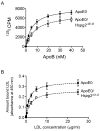Heparan sulfate in perlecan promotes mouse atherosclerosis: roles in lipid permeability, lipid retention, and smooth muscle cell proliferation
- PMID: 18596265
- PMCID: PMC2765377
- DOI: 10.1161/CIRCRESAHA.108.172833
Heparan sulfate in perlecan promotes mouse atherosclerosis: roles in lipid permeability, lipid retention, and smooth muscle cell proliferation
Erratum in
- Circ Res. 2009 Jan 30;104(2):e24
Abstract
Heparan sulfate (HS) has been proposed to be antiatherogenic through inhibition of lipoprotein retention, inflammation, and smooth muscle cell proliferation. Perlecan is the predominant HS proteoglycan in the artery wall. Here, we investigated the role of perlecan HS chains using apoE null (ApoE0) mice that were cross-bred with mice expressing HS-deficient perlecan (Hspg2(Delta3/Delta3)). Morphometry of cross-sections from aortic roots and en face preparations of whole aortas revealed a significant decrease in lesion formation in ApoE0/Hspg2(Delta3/Delta3) mice at both 15 and 33 weeks. In vitro, binding of labeled mouse triglyceride-rich lipoproteins and human LDL to total extracellular matrix, as well as to purified proteoglycans, prepared from ApoE0/Hspg2(Delta3/Delta3) smooth muscle cells was reduced. In vivo, at 20 minutes influx of human (125)I-LDL or mouse triglyceride-rich lipoproteins into the aortic wall was increased in ApoE0/Hspg2(Delta3/Delta3) mice compared to ApoE0 mice. However, at 72 hours accumulation of (125)I-LDL was similar in ApoE0/Hspg2(Delta3/Delta3) and ApoE0 mice. Immunohistochemistry of lesions from ApoE0/Hspg2(Delta3/Delta3) mice showed decreased staining for apoB and increased smooth muscle alpha-actin content, whereas accumulation of CD68-positive inflammatory cells was unchanged. We conclude that the perlecan HS chains are proatherogenic in mice, possibly through increased lipoprotein retention, altered vascular permeability, or other mechanisms. The ability of HS to inhibit smooth muscle cell growth may also influence development as well as instability of lesions.
Figures






Similar articles
-
Heparan sulfate side chains have a critical role in the inhibitory effects of perlecan on vascular smooth muscle cell response to arterial injury.Am J Physiol Heart Circ Physiol. 2014 Aug 1;307(3):H337-45. doi: 10.1152/ajpheart.00654.2013. Epub 2014 May 23. Am J Physiol Heart Circ Physiol. 2014. PMID: 24858854
-
Perlecan heparan sulfate deficiency impairs pulmonary vascular development and attenuates hypoxic pulmonary hypertension.Cardiovasc Res. 2015 Jul 1;107(1):20-31. doi: 10.1093/cvr/cvv143. Epub 2015 May 6. Cardiovasc Res. 2015. PMID: 25952902
-
Ablation of Perlecan Domain 1 Heparan Sulfate Reduces Progressive Cartilage Degradation, Synovitis, and Osteophyte Size in a Preclinical Model of Posttraumatic Osteoarthritis.Arthritis Rheumatol. 2016 Apr;68(4):868-79. doi: 10.1002/art.39529. Arthritis Rheumatol. 2016. PMID: 26636652
-
Lipoprotein modulation of subendothelial heparan sulfate proteoglycans (perlecan) and atherogenicity.Trends Cardiovasc Med. 2000 Feb;10(2):60-5. doi: 10.1016/s1050-1738(00)00048-7. Trends Cardiovasc Med. 2000. PMID: 11150731 Review.
-
Potential roles of vessel wall heparan sulfate proteoglycans in atherosclerosis.Vascul Pharmacol. 2014 Feb;60(2):49-51. doi: 10.1016/j.vph.2013.12.002. Epub 2013 Dec 12. Vascul Pharmacol. 2014. PMID: 24333941 Review.
Cited by
-
NAMPT knockdown attenuates atherosclerosis and promotes reverse cholesterol transport in ApoE KO mice with high-fat-induced insulin resistance.Sci Rep. 2016 May 27;6:26746. doi: 10.1038/srep26746. Sci Rep. 2016. PMID: 27229177 Free PMC article.
-
A current view of perlecan in physiology and pathology: A mosaic of functions.Matrix Biol. 2017 Jan;57-58:285-298. doi: 10.1016/j.matbio.2016.09.003. Epub 2016 Sep 6. Matrix Biol. 2017. PMID: 27613501 Free PMC article. Review.
-
Glycoconjugates and related molecules in human vascular endothelial cells.Int J Vasc Med. 2013;2013:963596. doi: 10.1155/2013/963596. Epub 2013 Sep 19. Int J Vasc Med. 2013. PMID: 24171112 Free PMC article. Review.
-
Treatment with chondroitin sulfate to modulate inflammation and atherogenesis in obesity.Atherosclerosis. 2016 Feb;245:82-7. doi: 10.1016/j.atherosclerosis.2015.12.016. Epub 2015 Dec 13. Atherosclerosis. 2016. PMID: 26714044 Free PMC article.
-
Prevention of TGFβ induction attenuates angII-stimulated vascular biglycan and atherosclerosis in Ldlr-/- mice.J Lipid Res. 2013 Aug;54(8):2255-2264. doi: 10.1194/jlr.P040139. Epub 2013 Jun 7. J Lipid Res. 2013. PMID: 23749984 Free PMC article.
References
-
- Wight TN, Merrilees MJ. Proteoglycans in atherosclerosis and restenosis: key roles for versican. Circ Res. 2004;94:1158–1167. - PubMed
-
- Engelberg H. Endogenous heparin activity deficiency: the ‘missing link’ in atherogenesis? Atherosclerosis. 2001;159:253–260. - PubMed
-
- Pillarisetti S. Lipoprotein modulation of subendothelial heparan sulfate proteoglycans (perlecan) and atherogenicity. Trends Cardiovasc Med. 2000;10:60–65. - PubMed
-
- Hollmann J, Schmidt A, von Bassewitz DB, Buddecke E. Relationship of sulfated glycosaminoglycans and cholesterol content in normal and arteriosclerotic human aorta. Arteriosclerosis. 1989;9:154–158. - PubMed
-
- Murata K, Yokoyama Y. Acidic glycosaminoglycan, lipid and water contents in human coronary arterial branches. Atherosclerosis. 1982;45:53–65. - PubMed
Publication types
MeSH terms
Substances
Grants and funding
LinkOut - more resources
Full Text Sources
Other Literature Sources
Medical
Molecular Biology Databases
Research Materials
Miscellaneous

